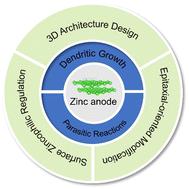Our official English website, www.x-mol.net, welcomes your
feedback! (Note: you will need to create a separate account there.)
Host-design strategies of zinc anodes for aqueous zinc-ion batteries
RSC Advances ( IF 3.9 ) Pub Date : 2024-07-22 , DOI: 10.1039/d4ra04353g Xuanyu Zhou 1 , Tingting Ruan 1 , Jie Xu 1 , Chenhao Li 1 , Shixuan Huang 1 , Jianping Zhou 1 , Shengli Lu 1 , Rensheng Song 2 , Ruhong Li 3
RSC Advances ( IF 3.9 ) Pub Date : 2024-07-22 , DOI: 10.1039/d4ra04353g Xuanyu Zhou 1 , Tingting Ruan 1 , Jie Xu 1 , Chenhao Li 1 , Shixuan Huang 1 , Jianping Zhou 1 , Shengli Lu 1 , Rensheng Song 2 , Ruhong Li 3
Affiliation

|
Aqueous zinc ion batteries (AZIBs) have garnered considerable interest as an eco-friendly, safe, and cost-effective energy storage solution. Although significant strides have been made in recent years, there remain technical hurdles to overcome. Herein, this review summarizes in detail the primary challenges confronting aqueous zinc ion batteries, including the rampant dendrite growth, and water-induced parasitic reactions, and proposes host-engineering modification strategies focusing on optimizing the structure design of the zinc anode substrates, involving three-dimensional structure design, zincophilicity regulation, and epitaxial-oriented modification, and comprehensively analyzes the structure–activity relationship between different modification strategies and battery performance. In addition, we highlight the research trends and prospects in future anode modification for aqueous zinc-ion batteries. This work offers valuable insights into advanced Zn anode constructions for further applications in high-performance AZIBs.
中文翻译:

水系锌离子电池锌负极的主体设计策略
水性锌离子电池(AZIB)作为一种环保、安全且经济高效的储能解决方案引起了人们的广泛关注。尽管近年来取得了重大进展,但仍存在需要克服的技术障碍。本文详细总结了水系锌离子电池面临的主要挑战,包括猖獗的枝晶生长和水引起的寄生反应,并提出了以优化锌阳极基板结构设计为重点的主机工程修改策略,涉及三个方面三维结构设计、亲锌性调控和外延定向修饰,全面分析不同修饰策略与电池性能之间的构效关系。此外,我们还重点介绍了未来水系锌离子电池负极改性的研究趋势和前景。这项工作为先进的锌阳极结构提供了宝贵的见解,以便在高性能 AZIB 中进一步应用。
更新日期:2024-07-22
中文翻译:

水系锌离子电池锌负极的主体设计策略
水性锌离子电池(AZIB)作为一种环保、安全且经济高效的储能解决方案引起了人们的广泛关注。尽管近年来取得了重大进展,但仍存在需要克服的技术障碍。本文详细总结了水系锌离子电池面临的主要挑战,包括猖獗的枝晶生长和水引起的寄生反应,并提出了以优化锌阳极基板结构设计为重点的主机工程修改策略,涉及三个方面三维结构设计、亲锌性调控和外延定向修饰,全面分析不同修饰策略与电池性能之间的构效关系。此外,我们还重点介绍了未来水系锌离子电池负极改性的研究趋势和前景。这项工作为先进的锌阳极结构提供了宝贵的见解,以便在高性能 AZIB 中进一步应用。

















































 京公网安备 11010802027423号
京公网安备 11010802027423号